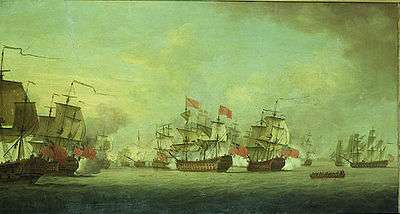HMS Lenox (1678)
HMS Lenox was a 70-gun third rate ship of the line of the Royal Navy, launched at Deptford Dockyard on 18 April 1678.[1]
museonavaldemadrid.jpg) Battle between the Spanish 70-gun Princesa (right foreground), and HMS Lenox, Orford and Kent, 8 April 1740 | |
| History | |
|---|---|
| Name: | HMS Lenox |
| Builder: | John Shish, Deptford Dockyard |
| Launched: | 1678 |
| Fate: | Sunk as a breakwater, 1756 |
| General characteristics as built[1] | |
| Class and type: | 70-gun third rate ship of the line |
| Tons burthen: | 1096 bm |
| Length: | 151 ft 6 in (46.2 m) (gundeck) |
| Beam: | 39 ft 8 in (12.1 m) |
| Depth of hold: | 17 ft (5.2 m) |
| Propulsion: | Sails |
| Sail plan: | Full rigged ship |
| Armament: | 70 guns of various weights of shot |
| General characteristics after 1701 rebuild[2] | |
| Class and type: | 70-gun third rate ship of the line |
| Tons burthen: | 1089 bm |
| Length: | 152 ft 7.5 in (46.5 m) (gundeck) |
| Beam: | 40 ft 3.5 in (12.3 m) |
| Depth of hold: | 17 ft 1 in (5.2 m) |
| Propulsion: | Sails |
| Sail plan: | Full rigged ship |
| Armament: | 70 guns of various weights of shot |
| General characteristics after 1723 rebuild[3] | |
| Class and type: | 1719 Establishment 70-gun third rate ship of the line |
| Tons burthen: | 1128 bm |
| Length: | 151 ft (46.0 m) (gundeck) |
| Beam: | 41 ft 6 in (12.6 m) |
| Depth of hold: | 17 ft 4 in (5.3 m) |
| Propulsion: | Sails |
| Sail plan: | Full rigged ship |
| Armament: |
|
She was rebuilt at Deptford in 1701, remaining as a 70-gun third rate.[2]
In 1702 William Jumper took this ship as his most notable command.[4] Lenox was part of Sir George Rooke's command during his unsuccessful attack on Cadiz in 1702, and was present at the capture of Gibraltar in 1704.[5] Lenox's captain was honoured by having Jumper's Bastion in Gibraltar named after him.

In 1707 Lenox was part of the fleet commanded by Sir Cloudesley Shovel, a substantial part of which was wrecked off the Scilly Isles. Lenox herself was undamaged and was able to return to Portmsouth after the disaster.[6] On 2 May 1721 she was ordered to be taken to pieces and rebuilt at Chatham as a 70-gun third rate to the 1719 Establishment. She was relaunched on 19 September 1723 and served until 1756, when she was sunk as a breakwater.[3]
Proposed sailing replica
In 2013 the Lenox Project (based in Deptford, London, UK) put forward a formal proposal to build a full-size sailing replica of the Lenox, to be constructed at a purpose-built museum on part of the site of the old Deptford Dockyard where the original Lenox was built.[7]
By late 2015 the project had gained momentum, with more detailed plans fitting the building of the Lenox into the overall development of Convoys Wharf, as the old Dockyard site is now known.[8][9]
If and when completed, the Lenox dock and museum would be within walking distance of the Cutty Sark museum in Greenwich.
Notes
- Lavery, Ships of the Line vol.1, p162.
- Lavery, Ships of the Line vol.1, p167.
- Lavery, Ships of the Line vol.1, p169.
- HMS Lennox, threedecks.org, accessed 3 May 2013
- Hills, George (1974). Rock of contention : a history of Gibraltar. London: Hale. p. 172. ISBN 0709143524.
- Sobel, Dava, Longitude: The True Story of a Lone Genius Who Solved the Greatest Scientific Problem of His Time, Fourth Estate Ltd., London 1998, p. 6, ISBN 1-85702-571-7
- "Build the Lenox". councilmeetings.lewisham.gov.uk. Lewisham Borough Council. 11 July 2013. Retrieved 19 May 2016.
- "The Lenox Project: a lasting legacy for Deptford". www.buildthelenox.org. The Lenox Project. 3 December 2015. Retrieved 19 May 2016.
- "Feasibility study report published by GLA". www.buildthelenox.org. The Lenox Project. 8 January 2016. Retrieved 19 May 2016.
References
- Lavery, Brian (2003) The Ship of the Line - Volume 1: The development of the battlefleet 1650-1850. Conway Maritime Press. ISBN 0-85177-252-8.